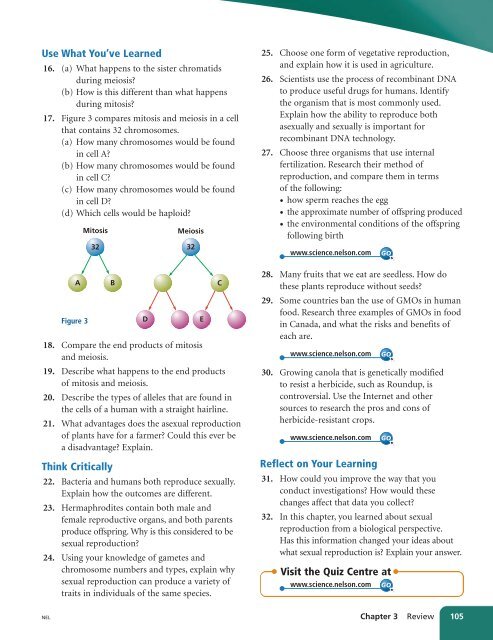Unit A Reproduction
Unit A Reproduction
Unit A Reproduction
You also want an ePaper? Increase the reach of your titles
YUMPU automatically turns print PDFs into web optimized ePapers that Google loves.
Use What You’ve Learned<br />
16. (a) What happens to the sister chromatids<br />
during meiosis?<br />
(b) How is this different than what happens<br />
during mitosis?<br />
17. Figure 3 compares mitosis and meiosis in a cell<br />
that contains 32 chromosomes.<br />
(a) How many chromosomes would be found<br />
in cell A?<br />
(b) How many chromosomes would be found<br />
in cell C?<br />
(c) How many chromosomes would be found<br />
in cell D?<br />
(d) Which cells would be haploid?<br />
A<br />
Figure 3<br />
Mitosis<br />
Meiosis<br />
32 32<br />
B<br />
18. Compare the end products of mitosis<br />
and meiosis.<br />
19. Describe what happens to the end products<br />
of mitosis and meiosis.<br />
20. Describe the types of alleles that are found in<br />
the cells of a human with a straight hairline.<br />
21. What advantages does the asexual reproduction<br />
of plants have for a farmer? Could this ever be<br />
a disadvantage? Explain.<br />
Think Critically<br />
22. Bacteria and humans both reproduce sexually.<br />
Explain how the outcomes are different.<br />
23. Hermaphrodites contain both male and<br />
female reproductive organs, and both parents<br />
produce offspring. Why is this considered to be<br />
sexual reproduction?<br />
24. Using your knowledge of gametes and<br />
chromosome numbers and types, explain why<br />
sexual reproduction can produce a variety of<br />
traits in individuals of the same species.<br />
D<br />
E<br />
C<br />
25. Choose one form of vegetative reproduction,<br />
and explain how it is used in agriculture.<br />
26. Scientists use the process of recombinant DNA<br />
to produce useful drugs for humans. Identify<br />
the organism that is most commonly used.<br />
Explain how the ability to reproduce both<br />
asexually and sexually is important for<br />
recombinant DNA technology.<br />
27. Choose three organisms that use internal<br />
fertilization. Research their method of<br />
reproduction, and compare them in terms<br />
of the following:<br />
• how sperm reaches the egg<br />
• the approximate number of offspring produced<br />
• the environmental conditions of the offspring<br />
following birth<br />
www.science.nelson.com<br />
28. Many fruits that we eat are seedless. How do<br />
these plants reproduce without seeds?<br />
29. Some countries ban the use of GMOs in human<br />
food. Research three examples of GMOs in food<br />
in Canada, and what the risks and benefits of<br />
each are.<br />
www.science.nelson.com<br />
30. Growing canola that is genetically modified<br />
to resist a herbicide, such as Roundup, is<br />
controversial. Use the Internet and other<br />
sources to research the pros and cons of<br />
herbicide-resistant crops.<br />
www.science.nelson.com<br />
GO<br />
GO<br />
GO<br />
Reflect on Your Learning<br />
31. How could you improve the way that you<br />
conduct investigations? How would these<br />
changes affect that data you collect?<br />
32. In this chapter, you learned about sexual<br />
reproduction from a biological perspective.<br />
Has this information changed your ideas about<br />
what sexual reproduction is? Explain your answer.<br />
Visit the Quiz Centre at<br />
www.science.nelson.com<br />
GO<br />
NEL<br />
Chapter 3 Review 105

















